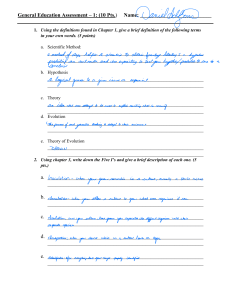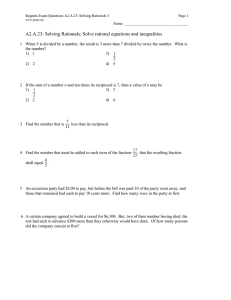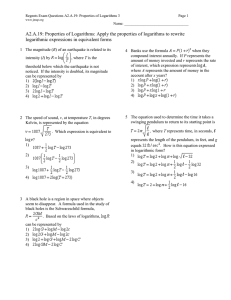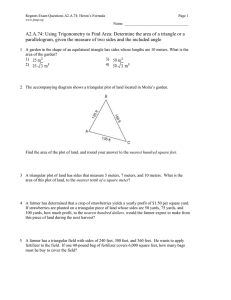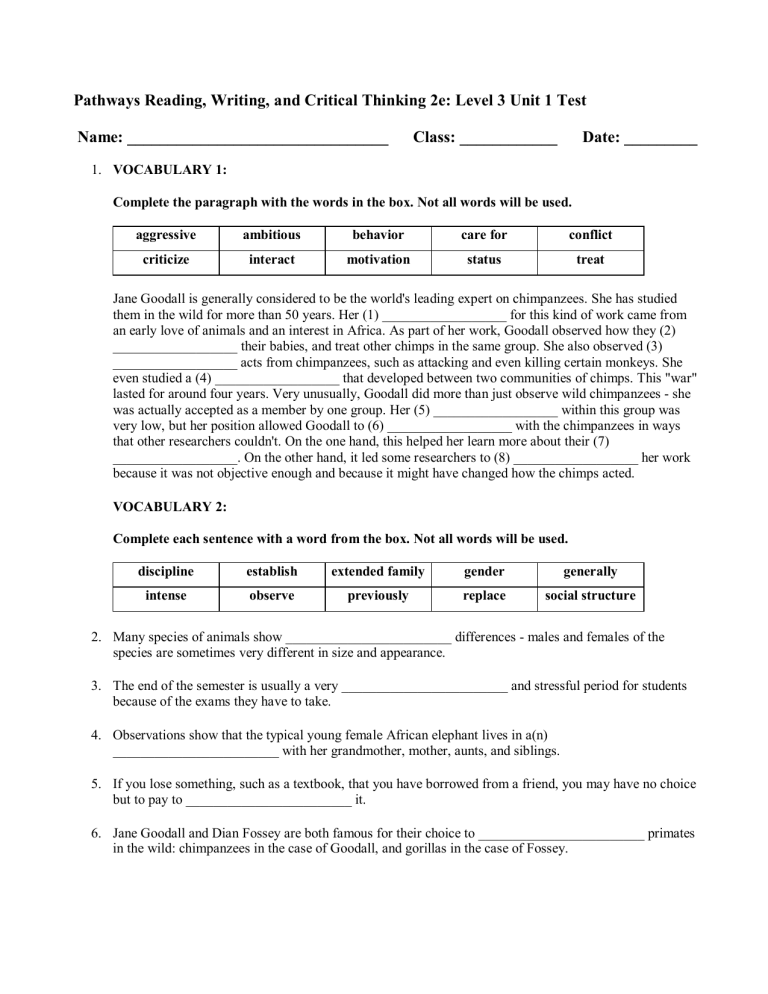
Pathways Reading, Writing, and Critical Thinking 2e: Level 3 Unit 1 Test Name: ________________________________ Class: ____________ Date: _________ 1. VOCABULARY 1: Complete the paragraph with the words in the box. Not all words will be used. aggressive ambitious behavior care for conflict criticize interact motivation status treat Jane Goodall is generally considered to be the world's leading expert on chimpanzees. She has studied them in the wild for more than 50 years. Her (1) __________________ for this kind of work came from an early love of animals and an interest in Africa. As part of her work, Goodall observed how they (2) __________________ their babies, and treat other chimps in the same group. She also observed (3) __________________ acts from chimpanzees, such as attacking and even killing certain monkeys. She even studied a (4) __________________ that developed between two communities of chimps. This "war" lasted for around four years. Very unusually, Goodall did more than just observe wild chimpanzees - she was actually accepted as a member by one group. Her (5) __________________ within this group was very low, but her position allowed Goodall to (6) __________________ with the chimpanzees in ways that other researchers couldn't. On the one hand, this helped her learn more about their (7) __________________. On the other hand, it led some researchers to (8) __________________ her work because it was not objective enough and because it might have changed how the chimps acted. VOCABULARY 2: Complete each sentence with a word from the box. Not all words will be used. discipline establish extended family gender generally intense observe previously replace social structure 2. Many species of animals show ________________________ differences - males and females of the species are sometimes very different in size and appearance. 3. The end of the semester is usually a very ________________________ and stressful period for students because of the exams they have to take. 4. Observations show that the typical young female African elephant lives in a(n) ________________________ with her grandmother, mother, aunts, and siblings. 5. If you lose something, such as a textbook, that you have borrowed from a friend, you may have no choice but to pay to ________________________ it. 6. Jane Goodall and Dian Fossey are both famous for their choice to ________________________ primates in the wild: chimpanzees in the case of Goodall, and gorillas in the case of Fossey. 7. Professors can become frustrated if their students ask numerous questions about points they have ________________________ covered in lectures. 8. Among animals that live in packs, such as wolves, the "alpha" male will typically ________________ dominance over other animals through shows of strength and aggression. READING REVIEW: Review the excerpts from the reading passages in Unit 1. Then answer the questions. The Ape in the Office Does the "office jungle" mirror behavior in the real jungle? New research shows people in offices may use conflict and cooperation in similar ways to primates in the jungle. Animal behavior specialist Richard Conniff is the author of The Ape in the Corner Office. In his book, Conniff examines corporate behavior through the eyes of a primatologist. He suggests cooperation is the key to success for both humans and other primates. He sees similarities in the ways they use social networks and hierarchies to gain status. He also points out that while conflict can be effective at times, both humans and apes usually prefer to cooperate. People often think that the animal world is full of conflict. However, conflict and aggression actually play a smaller role in the wild than cooperation. In fact, according to Conniff, both humans and other primates are social creatures, and both groups normally try to avoid conflict. Chimpanzees, for example, typically spend their days caring for their young and traveling together in small groups. Conniff points out that chimps spend about 5 percent of the day being aggressive, but 15 to 20 percent of the day grooming each other. For humans and other primates, conflict is rare and does not last long. For both species, cooperation is a more effective way to succeed and survive. Research also shows that people and other primates use similar social networking strategies to get ahead in life. They create tight social bonds by sharing resources, doing each other favors, building teams, and making friends. Employees with ambitious career goals, for example, often rely on powerful people in their office to help them get better jobs. In a similar way, chimps work to strengthen relationships with other chimps. Frans de Waal, a primatologist at Emory University in Atlanta, Georgia, claims that for chimps, "you can never reach a high position in their world if you don't have friends who help you." In fact, research shows that chimps often create bonds to strengthen their status, or importance, in the community. They do favors for one another and share resources. They sometimes also use their cunning to get ahead. "In chimps a common strategy is to break up alliances that can be used against them," de Waal explains. "They see a main rival sitting with someone else and they try to break up [that meeting]." Gender in the Wild How does gender impact family relationships in the wild? Recent studies show how gender influences the social structure of elephants, geladas, and chimps. Young elephants grow up in extended matriarchal families. Elephant mothers, aunts, grandmothers, and female friends cooperate to raise babies in large, carefully organized groups. This system helps protect young orphan elephants when hunters or farmers kill their mothers. When a young elephant is orphaned, other females take over the dead mother's role. The strong bonds between females continue throughout their lives, which can be as long as 70 years. In contrast, young male elephants stay close to their female family members until they are 14. Then they generally leave their mothers and form other groups with male elephants. Previously, male elephants were perceived to be less social than females. However, a recent study at Etosha National Park in Namibia shows that males often form intense, long-lasting friendships with other males. During the study, Stanford University behavioral psychologist Caitlin O'Connell-Rodwell found that each member knew his status, and that the group followed a strict social hierarchy. Older males act as teachers and mediators for younger ones, controlling or disciplining them when conflict occurs. These strict rules of behavior are helpful when food and drink are scarce. O'Connell-Rodwell observed that "in dry years, the strict pecking order they establish benefits all of them." For example, the young bulls know they must get in line behind the more senior elephants. In this way, everyone gets a turn to eat and drink, conflict is avoided, and peace is maintained. Geladas are primates that live in the remote highlands of Ethiopia. Males are larger than females, but females have the real power in family groups. Wildlife biologist Chadden Hunter studies geladas in Simen Mountains National Park in Ethiopia. Hunter has observed that typical family units have between two and eight adult females, their offspring, and a primary male, which researchers call the family male. Gelada males have little say in what the family does from day to day. The females decide where and how long to graze for food, when to move, and where to sleep. They also choose which male will be their mate and when it is time to replace that mate. Young bachelor males live in separate groups. They spend most of their time observing family groups and looking for opportunities to challenge the family males. When a young bachelor comes too close to a family, the family male chases him away. ____ 9. In which passage(s) does the author compare the behavior of animals and humans? a. The Ape in the Office b. Gender in the Wild c. Both The Ape in the Office and Gender in the Wild ____ 10. In which passage(s) does the author contrast the roles of male and female animals? a. The Ape in the Office b. Gender in the Wild c. Both The Ape in the Office and Gender in the Wild ____ 11. In which passage(s) does the author describe the behavior of animals within groups? a. The Ape in the Office b. Gender in the Wild c. Both The Ape in the Office and Gender in the Wild ____ 12. In which passage(s) does the author discuss aggressive behavior by animals? a. The Ape in the Office b. Gender in the Wild c. Both The Ape in the Office and Gender in the Wild ____ 13. In which passage(s) does the author explain how some animals raise children? a. The Ape in the Office b. Gender in the Wild c. Both The Ape in the Office and Gender in the Wild ____ 14. In which passage(s) does the author talk about how status affects the behavior of animals? a. The Ape in the Office b. Gender in the Wild c. Both The Ape in the Office and Gender in the Wild ____ 15. Which passage(s) mention that animals may work together or against each other? a. The Ape in the Office b. Gender in the Wild c. Both The Ape in the Office and Gender in the Wild READING PRACTICE: Read the passage. Then answer the questions. A Why do human beings have such large brains? Scientists used to think that large, intelligent brains evolved so that early people could make tools and solve problems. A more recent version of this idea is related to climate change. At the time that large brains like ours appeared in early humans, global weather patterns were changing a great deal. Some scientists suggest that big brains would help humans plan and adapt to new climates and environments. However, the theory that is the most popular these days - the Cultural Brain Hypothesis - is that our large brains are mainly the result of our living in large, complicated social groups. B Without a time machine, it is difficult to prove the Cultural Brain Hypothesis. The best evidence comes from comparing humans to animals that have similar social groups. Apes and monkeys live in social groups that are similar to our own in many ways. There is also a clear relationship between brain size and social behavior. Basically, the more complicated their social groups, the larger their relative brain size is. However, these observations do not mean that the Cultural Brain Hypothesis is true. Perhaps large brains come first for other reasons, and complex social relationships only happen later. To really find strong evidence that social relationships lead to large brains, we need to study other intelligent animals that are quite different from humans and other primates. Fortunately such a group exists: dolphins and whales. C Dolphins and whales, known as cetaceans, also have very large brains compared to other animals. However, these large brains appeared in an ocean environment very different from the dry land where humans and apes evolved. As a result, the structure of their brains is markedly different from that of humans. In the past, many scientists believed that, despite their obvious intelligence and complex behaviors, cetaceans did not have the same kind of social intelligence as humans. However, recent studies suggest that cetacean social relationships are surprisingly similar to our own. And now it is believed that it is indeed these complex social relationships that are the main reason why large brains evolved in the first place. D It is now known that many cetaceans show social behavior that was previously thought only to exist in humans and other primates. For example, scientists now realize that cetacean communication is both rich and expressive, and studies show some species have individual names for different members of the group. Additionally, different groups have their own distinct sounds, just as people from different areas have their own accents or special vocabulary. The relationships between adult cetaceans and young members of the group are also surprisingly familiar. Adult cetaceans will often look after the young of other members of the group in the same way human uncles, aunts, or grandparents might babysit for absent parents. Young cetaceans also learn by watching and imitating adult members of the group just as humans learn from adult teachers. Finally, like any collection of humans, cetaceans have friends and enemies among the members of their social group. They will act in a friendly way when hunting or defending their group from danger, but may fight with "enemies" for various reasons. E More importantly for the Cultural Brain Hypothesis, there is also a close relationship between brain size in cetaceans and how complex their social behavior is. Whales and dolphins that live in smaller groups or by themselves have both smaller brains and simpler social behavior. Therefore, the same relationship between brain size and social behavior is seen in two very different groups of animals primates and cetaceans. This supports the idea that social behavior may be one of the main factors driving larger brain size and higher intelligence. Reference: National Center for Biotechnology Information ____ 16. What is the best title for this passage? a. How Culture Developed among Primates and Cetaceans b. The Effect of Ocean Environments on Animal Societies c. Cetacean Intelligence and the Cultural Brain Hypothesis ____ 17. Which answer best describes paragraph A? a. It gives a detailed analysis of an important theory. b. It includes a comparison of several contrasting ideas. c. It offers a criticism of changing scientific views. ____ 18. Why does the author mention a time machine in paragraph B? a. To imply that scientific hypotheses were less developed in the past b. To emphasize the impossibility of finding out if a theory is correct c. To compare ideas about intelligence with ideas from science fiction ____ 19. What point does the author NOT make in paragraph C? a. Scientific ideas about cetaceans have changed as a result of research studies. b. Dolphins and whales engage in social behaviors that are like those of humans. c. If whales and dolphins lived on land, they would probably have smaller brains. ____ 20. The word "markedly" in paragraph C is closest in meaning to ____. a. significantly b. potentially c. frequently ____ 21. In paragraph D, the author gives an example of _____. a. the value of effective communication b. the expressiveness of cetacean communication c. special words used by dolphins or whales ____ 22. The word "their" in the last sentence of paragraph D refers to _____. a. enemies b. friends c. cetaceans ____ 23. What can be inferred from paragraph E? a. The author feels the Cultural Brain Hypothesis is probably correct. b. The brains of primates and cetaceans are continuing to grow in size. c. Whales, dolphins, and humans all need strong social relationships. READING SKILL REVIEW - IDENTIFYING MAIN AND SUPPORTING IDEAS: Read the passage. Then decide whether each statement is a main idea or a supporting idea from the passage. A Why do human beings have such large brains? Scientists used to think that large, intelligent brains evolved so that early people could make tools and solve problems. A more recent version of this idea is related to climate change. At the time that large brains like ours appeared in early humans, global weather patterns were changing a great deal. Some scientists suggest that big brains would help humans plan and adapt to new climates and environments. However, the theory that is the most popular these days - the Cultural Brain Hypothesis - is that our large brains are mainly the result of our living in large, complicated social groups. B Without a time machine, it is difficult to prove the Cultural Brain Hypothesis. The best evidence comes from comparing humans to animals that have similar social groups. Apes and monkeys live in social groups that are similar to our own in many ways. There is also a clear relationship between brain size and social behavior. Basically, the more complicated their social groups, the larger their relative brain size is. However, these observations do not mean that the Cultural Brain Hypothesis is true. Perhaps large brains come first for other reasons, and complex social relationships only happen later. To really find strong evidence that social relationships lead to large brains, we need to study other intelligent animals that are quite different from humans and other primates. Fortunately such a group exists: dolphins and whales. C Dolphins and whales, known as cetaceans, also have very large brains compared to other animals. However, these large brains appeared in an ocean environment very different from the dry land where humans and apes evolved. As a result, the structure of their brains is markedly different from that of humans. In the past, many scientists believed that, despite their obvious intelligence and complex behaviors, cetaceans did not have the same kind of social intelligence as humans. However, recent studies suggest that cetacean social relationships are surprisingly similar to our own. And now it is believed that it is indeed these complex social relationships that are the main reason why large brains evolved in the first place. D It is now known that many cetaceans show social behavior that was previously thought only to exist in humans and other primates. For example, scientists now realize that cetacean communication is both rich and expressive, and studies show some species have individual names for different members of the group. Additionally, different groups have their own distinct sounds, just as people from different areas have their own accents or special vocabulary. The relationships between adult cetaceans and young members of the group are also surprisingly familiar. Adult cetaceans will often look after the young of other members of the group in the same way human uncles, aunts, or grandparents might babysit for absent parents. Young cetaceans also learn by watching and imitating adult members of the group just as humans learn from adult teachers. Finally, like any collection of humans, cetaceans have friends and enemies among the members of their social group. They will act in a friendly way when hunting or defending their group from danger, but may fight with "enemies" for various reasons. E More importantly for the Cultural Brain Hypothesis, there is also a close relationship between brain size in cetaceans and how complex their social behavior is. Whales and dolphins that live in smaller groups or by themselves have both smaller brains and simpler social behavior. Therefore, the same relationship between brain size and social behavior is seen in two very different groups of animals primates and cetaceans. This supports the idea that social behavior may be one of the main factors driving larger brain size and higher intelligence. Reference: National Center for Biotechnology Information ____ 24. There are several theories that explain how humans developed very large brains. a. This is the main idea of paragraph A. b. This is a supporting idea from paragraph A. ____ 25. Humans, apes, and monkeys live in similar social groups. a. This is the main idea of paragraph B. b. This is a supporting idea from paragraph B. ____ 26. Humans and cetaceans evolved in very different environments. a. This is the main idea of paragraph C. b. This is a supporting idea from paragraph C. ____ 27. Like humans, cetaceans display numerous kinds of complex social behavior. a. This is the main idea of paragraph D. b. This is a supporting idea from paragraph D. ____ 28. Some cetaceans live in large groups, others live in smaller groups. a. This is the main idea of paragraph E. b. This is a supporting idea from paragraph E. LANGUAGE FOR WRITING REVIEW - MAKING COMPARISONS: Complete each short statement with an expression from the box. Remember to use a capital letter if necessary. Not all expressions will be used. are similar both in contrast like on the one hand while 29. Although many people have a phobia of them, spiders, ________________ bats, are beneficial because they eat insects. 30. Surprisingly, ________________ capybaras and jerboas are rodents, though the former may weigh 90 kilograms, and the latter just 90 grams. 31. Most primates and some species of birds regularly use tools to perform tasks. ________________ , most other species rarely or never use tools. 32. Dolphins ________________ to humans in some ways: both are intelligent species that live in social groups and communicate using complex language. 33. ________________ it is true that camels can survive for months without drinking, it is a myth that they store water in the humps on their backs. WRITING SKILL REVIEW - WRITING BODY PARAGRAPHS: These four sentences are part of a body paragraph. What is the function of each sentence? • Although rabbits and hares also have long front teeth, they are not classed as rodents. • Most of them are relatively small, have short legs, a long tail, and long front teeth. • Rodents, which are the the largest group of mammals, share certain characteristics. • Some well-known examples of rodents include mice, rats, prairie dogs, and beavers. ____ 34. Although rabbits and hares also have long front teeth, they are not classed as rodents. a. It is a topic sentence. b. It provides supporting information. c. It gives examples related to the topic. d. It introduces a contrasting topic. ____ 35. Most of them are relatively small, have short legs, a long tail, and long front teeth. a. It is a topic sentence. b. It provides supporting information. c. It gives examples related to the topic. d. It introduces a contrasting topic. ____ 36. Rodents, which are the the largest group of mammals, share certain characteristics. a. It is a topic sentence. b. It provides supporting information. c. It gives examples related to the topic. d. It introduces a contrasting topic. ____ 37. Some well-known examples of rodents include mice, rats, prairie dogs, and beavers. a. It is a topic sentence. b. It provides supporting information. c. It gives examples related to the topic. d. It introduces a contrasting topic. WRITING PRACTICE 1: Put the phrases in parentheses in order to make a grammatically correct sentence. 38. Both falcons and hawks are classified as raptors, but they differ in a number of ways. ( the former catch prey with / to give one example, / their beaks, / the latter use their feet / while ) _____________________________________________________________________ _____________________________________________________________________ 39. ( cats have / developed a / like dogs and horses, / mutually beneficial / with humans / relationship ) In contrast to the other two species, which are still often used as working animals, most cats are pets. _____________________________________________________________________ _____________________________________________________________________ 40. Despite its name, killer whales are actually dolphins. ( are fish, / similarly, / not a type of whale / whale sharks ) In both cases, the "whale" part of their name describes their size, not their species. _____________________________________________________________________ _____________________________________________________________________ 41. Bonobos, which are one type of primate, are genetically almost identical to chimpanzees. ( but unlike chimps, / bonobos / often aggressive, / live peaceful lives / tend to / which are ) _____________________________________________________________________ _____________________________________________________________________ 42. Surveys show that many people think humans are the only species to feel emotions, but this belief may be false. ( death of / that some animals / family members / react with / research suggests / sadness / to the ) _____________________________________________________________________ _____________________________________________________________________ WRITING PRACTICE 2: Compare and contrast humans with another animal. 43. Complete the thesis statement. Then write two body paragraphs (one on similarities and one on differences). Use comparison expressions when you write, and make sure you include topic sentences and supporting ideas and details. Thesis Statement Humans and ____________________________________ are similar in some ways but different in others. On the one hand, both of them ____________________________________________. However, ____________________________________________. UNIT 1: SOCIAL RELATIONSHIPS Answer Section 1. ANS: (1) motivation, (2) care for, (3) aggressive, (4) conflict, (5) status, (6) interact, (7) behavior, (8) criticize motivation, care for, aggressive, conflict, status, interact, behavior, criticize PTS: 8 2. ANS: gender REF: PWRW3, Unit 1 TOP: Vocabulary 1 PTS: 1 3. ANS: intense REF: PWRW3, Unit 1 TOP: Vocabulary 2 PTS: 1 REF: PWRW3, Unit 1 4. ANS: extended family TOP: Vocabulary 2 PTS: 1 5. ANS: replace REF: PWRW3, Unit 1 TOP: Vocabulary 2 PTS: 1 6. ANS: observe REF: PWRW3, Unit 1 TOP: Vocabulary 2 PTS: 1 7. ANS: previously REF: PWRW3, Unit 1 TOP: Vocabulary 2 PTS: 1 8. ANS: establish REF: PWRW3, Unit 1 TOP: Vocabulary 2 PTS: 9. ANS: TOP: 10. ANS: TOP: 11. ANS: TOP: 12. ANS: TOP: 13. ANS: TOP: 14. ANS: TOP: 15. ANS: TOP: 16. ANS: TOP: 17. ANS: TOP: 1 REF: A PTS: Reading Review B PTS: Reading Review C PTS: Reading Review C PTS: Reading Review B PTS: Reading Review C PTS: Reading Review A PTS: Reading Review C PTS: Reading Practice B PTS: Reading Practice PWRW3, Unit 1 TOP: Vocabulary 2 1 REF: PWRW3, Unit 1 1 REF: PWRW3, Unit 1 1 REF: PWRW3, Unit 1 1 REF: PWRW3, Unit 1 1 REF: PWRW3, Unit 1 1 REF: PWRW3, Unit 1 1 REF: PWRW3, Unit 1 1 REF: MSC: REF: MSC: 1 PWRW3, Unit 1 TOEFL PWRW3, Unit 1 TOEFL 18. ANS: TOP: 19. ANS: TOP: 20. ANS: TOP: 21. ANS: TOP: 22. ANS: TOP: 23. ANS: TOP: 24. ANS: TOP: 25. ANS: TOP: 26. ANS: TOP: 27. ANS: TOP: 28. ANS: TOP: 29. ANS: like B PTS: 1 REF: PWRW3, Unit 1 Reading Practice MSC: TOEFL C PTS: 1 REF: PWRW3, Unit 1 Reading Practice MSC: TOEFL A PTS: 1 REF: PWRW3, Unit 1 Reading Practice MSC: TOEFL B PTS: 1 REF: PWRW3, Unit 1 Reading Practice MSC: TOEFL C PTS: 1 REF: PWRW3, Unit 1 Reading Practice MSC: TOEFL A PTS: 1 REF: PWRW3, Unit 1 Reading Practice MSC: TOEFL A PTS: 1 REF: PWRW3, Unit 1 Reading Skill Review - Identifying Main and Supporting Ideas B PTS: 1 REF: PWRW3, Unit 1 Reading Skill Review - Identifying Main and Supporting Ideas B PTS: 1 REF: PWRW3, Unit 1 Reading Skill Review - Identifying Main and Supporting Ideas A PTS: 1 REF: PWRW3, Unit 1 Reading Skill Review - Identifying Main and Supporting Ideas B PTS: 1 REF: PWRW3, Unit 1 Reading Skill Review - Identifying Main and Supporting Ideas PTS: 1 REF: PWRW3, Unit 1 TOP: Language for Writing Review - Making Comparisons 30. ANS: both PTS: 1 REF: PWRW3, Unit 1 TOP: Language for Writing Review - Making Comparisons 31. ANS: In contrast PTS: 1 REF: PWRW3, Unit 1 TOP: Language for Writing Review - Making Comparisons 32. ANS: are similar PTS: 1 REF: PWRW3, Unit 1 TOP: Language for Writing Review - Making Comparisons 33. ANS: While PTS: TOP: 34. ANS: TOP: 1 REF: PWRW3, Unit 1 Language for Writing Review - Making Comparisons D PTS: 1 REF: PWRW3, Unit 1 Writing Skill Review - Writing Body Paragraphs 35. ANS: B PTS: 1 REF: PWRW3, Unit 1 TOP: Writing Skill Review - Writing Body Paragraphs 36. ANS: A PTS: 1 REF: PWRW3, Unit 1 TOP: Writing Skill Review - Writing Body Paragraphs 37. ANS: C PTS: 1 REF: PWRW3, Unit 1 TOP: Writing Skill Review - Writing Body Paragraphs 38. ANS: To give one example, the former catch prey with their beaks, while the latter use their feet. PTS: 1 REF: PWRW3, Unit 1 TOP: Writing Practice 1 39. ANS: Like dogs and horses, cats have developed a mutually beneficial relationship with humans. PTS: 1 REF: PWRW3, Unit 1 40. ANS: Similarly, whale sharks are fish, not a type of whale. TOP: Writing Practice 1 PTS: 1 REF: PWRW3, Unit 1 TOP: Writing Practice 1 41. ANS: But unlike chimps, which are often aggressive, bonobos tend to live peaceful lives. PTS: 1 REF: PWRW3, Unit 1 TOP: Writing Practice 1 42. ANS: Research suggests that some animals react with sadness to the death of family members. PTS: 1 43. ANS: Answers will vary. PTS: 5 REF: PWRW3, Unit 1 TOP: Writing Practice 1 REF: PWRW3, Unit 1 TOP: Writing Practice 2
